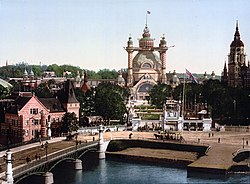Djurgårdsbron

Djurgårdsbron (
Featured on the bridge standing on tall
History


Preceded by a bridge much further east and thus simply referred to as "the new bridge", the original bridge at this location first appears on a map dated 1696. However, duties covering the costs for material and carpenters required for its construction are brought up in the Royal accounts as early as 1661.[2] [3]
Appearing together with the original bridge on a map dated 1733, a new bridge built in 1730 by King Frederick I (1676–1751) requiring a roadworthy passage to the Royal hunting grounds, was referred to as Fredrikshovsbron ("The Court of Frederick Bridge") due to its vicinity to the palace Fredrikshov. Concerned for the state of the bridge, the king six years later had the bridge leased out to the island's surveyor, who, made responsible for its maintenance, was authorized to take up bridge tolls fixed by the king. The bridge gave way, non the less, under the king's coach in 1745.[2][3]
The bridge is mentioned again in 1801, then referred to as Djurgårdsflottbro ("The Djurgården
Reinforced in 1886, the iron bridge was demolished in 1895 to be replaced by the current three-span steel bridge, 18 metres wide, about 58 metres long, and able to carry the new
See also
References
- ^ "Djurgårdsbron". Swedish Wikipedia. 2006-09-07. Retrieved 2007-01-10.
- ^ a b c d
Dufwa, Arne (1985). "Broar och viadukter: Djurgårdsbron". Stockholms tekniska historia: Trafik, broar, tunnelbanor, gator. Uppsala: Stockholms gatukontor and Kommittén för Stockholmsforskning. pp. 197–198. ISBN 91-38-08725-1.
- ^ a b c d
"Djurgården". Stockholms gatunamn (2nd ed.). Stockholm: Kommittén för Stockholmsforskning. 1992. p. 39. ISBN 91-7031-042-4.
External links
- Stockholmskällan - historical images of Djurgårdsbron.
